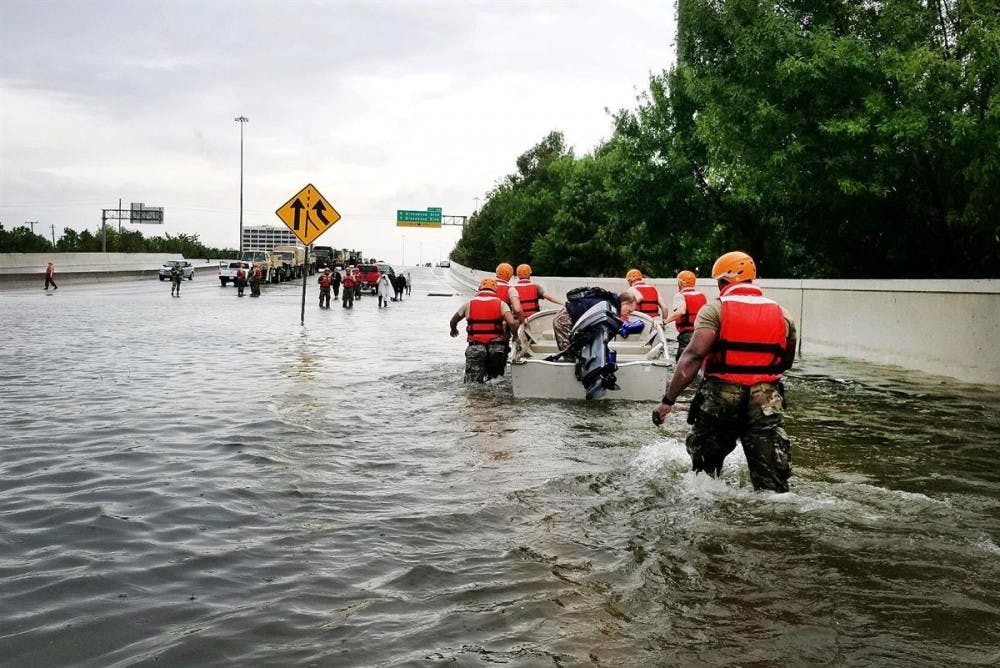On Friday Aug. 25, an unrelenting storm tore across the east side of Houston. Named “Hurricane Harvey,” the catastrophe left thousands of Texans homeless and forced to evacuate to emergency shelters.
About one-third of the city is now underwater and the total death count related to the hurricane and its aftermath is now almost 40. The storm began in Harris County but spread throughout the region, dumping more than 14 trillion gallons of water on Texas (compared to Hurricane Katrina’s 6.5 trillion gallons.) Currently it is unclear how many more people need to be rescued, according to the Texas Military Department.
But what caused this devastating impact? And how can future storms like Harvey be prevented?
Researchers have claimed that the hurricane can in part be explained by climate change. Due in part to global warming, water in the Gulf of Mexico is unusually warm for this time of year, about 2.7 to 7.2 degrees Fahrenheit above average. The warm water provided a hot spot for the storm to develop into a Category four hurricane.
“The hurricane is a naturally occurring hazard that is exacerbated by climate change,” Katharine Hayhoe, an atmospheric scientist and professor of political science at Texas Tech University told the Huffington Post. “But the actual risk to Houston is a combination of the hazard—rainfall, storm surge and wind, the vulnerability, and the exposure.”
Climate scientists also note that the hurricane can be attributed to Houston’s lack of “green space” which helps to soak up rain. Urban sprawl and an increase in concrete over green space caused the city to lose some of its capacity to absorb water.
Houston’s weak and aging infrastructure also worsened the effects of the hurricane. Houston is particularly prone to flooding because the city is completely flat, making drainage difficult.
In addition to warmer temperatures, global warming has also contributed to higher sea levels which caused the effects of Harvey to be greater than they would have been in previous decades. According to a study done by the National Oceanic and Atmospheric Administration, storm surges today are an average of seven inches higher than they were 30 years ago. Climatologists estimate that global sea levels will continue to rise an average of one to eight feet in the coming years.
Scientists have also claimed that sea surface temperatures have risen about one degree in the last few decades. This one degree increase corresponds to a three to five percent more moisture in the south coast of Texas.
“As for the contributions of climate change — any responsible scientist will tell you that it is not possible to attribute any particular event to climate change,” Ciaran Harman, assistant professor of landscape hydrology, wrote in an email to The News-Letter. “However, we know that climate change is leading to higher sea surface temperatures, and that high sea surface temperatures make hurricanes stronger.”
In recent years, Hopkins has been preparing itself for massive floods. According to Harman, floods typically occur because the water flowing into an area is greater than the rate it can flow out. He stated that the solution in the past often deals with increasing the rate of outflow by using concrete channels and drains. But this can pose problems for areas downstream.
“These days we try to take a more holistic approach by creating more storage in the upstream parts of the landscape. This can be done by reducing the amount of impervious area or routing runoff from impervious areas into rain gardens and bioretention ponds,” Harman wrote. “In the last year Hopkins has built several of these. Most visible are the bio-retention pond on San Martin Drive right where it meets University, and along the side of Wyman Park Drive next to the child care center.”
Harman added that these modern storm management systems help to protect both the environment and infrastructure. Harman said that Houston has been criticized for not having enough of these systems. However, he believes that these systems would not have helped the Harvey situation much because of the large amount of rainfall that Houston received in comparison to its typical rainfall.
“The water table in Houston is relatively high and the soils high in clay, so the water can’t seep in easily. The old conveyance-based methods are not helping much either — Houston is very flat, so you can’t drain the water away quickly,” Harvey wrote. “There are other things that can be done to mitigate future risks. It helps to have policies in place that deter or prevent people from building in floodplains.”





